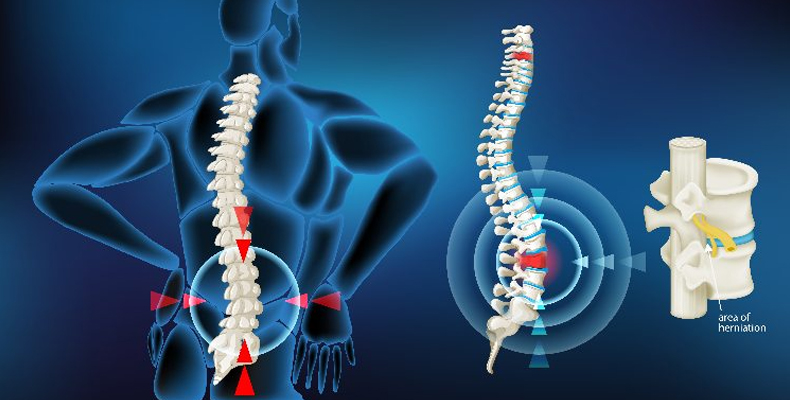
Disc Prolapse
A disc prolapse, commonly known as a herniated disc or slipped disc, occurs when the soft, gel-like center (nucleus pulposus) of an intervertebral disc protrudes through a tear in the outer annulus fibrosus. This condition can occur in any part of the spine but most commonly affects the lumbar (lower back) and cervical (neck) regions. The herniation may press on nearby nerves, leading to pain, numbness, or weakness in the corresponding areas of the body.
Here are key points about disc prolapse:
Causes:
- Age-related Degeneration: The discs in the spine undergo wear and tear over time, making them more susceptible to herniation.
- Trauma or Injury: Sudden or repetitive movements, lifting heavy objects, or accidents can contribute to disc prolapse.
- Genetics: Some individuals may have a genetic predisposition to disc-related problems.
Symptoms:
- Pain: The location and severity of pain depend on the affected disc and the nerves involved. Commonly, pain is felt in the lower back (for lumbar disc prolapse) or neck (for cervical disc prolapse).
- Radiating Pain: Pain may radiate into the buttocks, legs, feet, arms, or hands, depending on the location of the herniated disc.
- Numbness and Tingling: Compression of nerves can lead to sensations of numbness, tingling, or weakness in the affected areas.
- Muscle Weakness: In severe cases, muscle weakness may occur in the affected extremities.
Diagnosis:
- Clinical Evaluation: A healthcare professional will assess the patient's medical history, symptoms, and conduct a physical examination.
- Imaging Studies: X-rays, MRI (Magnetic Resonance Imaging), or CT (Computed Tomography) scans may be ordered to visualize the spine and confirm the diagnosis.
Treatment Options:
-
Conservative Measures:
- Rest and Activity Modification: Avoiding activities that worsen symptoms.
- Physical Therapy: Specific exercises to strengthen muscles and improve flexibility.
- Pain Medications: Over-the-counter or prescription medications to manage pain and inflammation.
-
Medical Interventions:
- Epidural Steroid Injections: Injection of anti-inflammatory medication into the affected area.
- Muscle Relaxants or Analgesics: Medications to alleviate pain and muscle spasms.
-
Surgical Options:
- Surgery may be considered if conservative measures are ineffective, and the symptoms are severe or progressive.
- Discectomy: Surgical removal of the herniated portion of the disc.
- Laminectomy: Removal of a part of the vertebral bone (lamina) to relieve pressure on the nerves.
Recovery:
- Many individuals with disc prolapse experience improvement with conservative treatments. Surgery is typically reserved for cases where non-surgical methods are ineffective or in severe situations.
It's crucial to consult with a healthcare professional for an accurate diagnosis and appropriate treatment plan based on the individual's specific condition and symptoms. Early intervention and proper management can significantly contribute to a successful recovery.